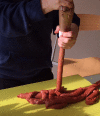Gastroschisis Simulation Model: Pre-surgical Management Technical Report
- PMID: 28439484
- PMCID: PMC5400515
- DOI: 10.7759/cureus.1109
Gastroschisis Simulation Model: Pre-surgical Management Technical Report
Abstract
This technical report describes the creation of a gastroschisis model for a newborn. This is a simple, low-cost task trainer that provides the opportunity for Neonatology providers, including fellows, residents, nurse practitioners, physician assistants, and nurses, to practice the management of a baby with gastroschisis after birth and prior to surgery. Included is a suggested checklist with which the model can be employed. The details can be modified to suit different learning objectives.
Keywords: abdominal wall defect; delivery room; gastroschisis; newborn; pre-surgical management; resuscitation.
Conflict of interest statement
The authors have declared that no competing interests exist.
Figures







References
-
- The epidemiology, prevalence and hospital outcomes of infants with gastroschisis. Allman R, Sousa J, Walker MW, et al. J Perinatol. 2016;36:901–905. - PubMed
-
- Management of gastroschisis. Skarsgard ED. Curr Opin Pediatr. 2016;28:363–369. - PubMed
-
- Simulation in the early management of gastroschisis. Bacarese-Hamilton J, Pena V, Haddad M, et al. Simul Healthc. 2013;8:376–381. - PubMed
-
- Just-in-time training for high-risk low-volume therapies: an approach to ensure patient safety. Helman S, Lisanti AJ, Adams A, et al. J Nurs Care Qual. 2016;31:33–39. - PubMed
LinkOut - more resources
Full Text Sources
Other Literature Sources
